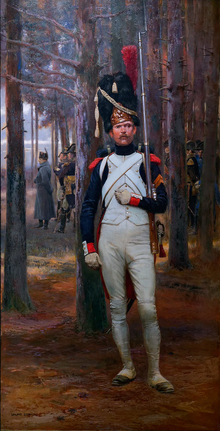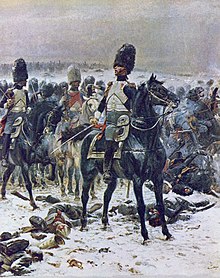Old Guard (France)
| Old Guard | |
|---|---|
| Vieille garde | |
 | |
| Active | 1804–1815 |
| Country | |
| Branch | |
| Engagements | Napoleonic Wars |
| Commanders | |
| Notable commanders | Dorsenne Bessières Davout Soult Cambronne |
The Old Guard (French: Vieille garde) was a formation of the French Imperial Army's Imperial Guard. Consisting exclusively of veteran troops, it was the most prestigious formation in Napoleon's Grande Armée.[1][2] French soldiers often referred to Napoleon's Old Guard as "the Immortals".[3][4]
Famously devoted to the Emperor,[5] who even referred to them as "my children";[6] the members of his Old Guard were selected based on physical traits, most notably above-average height.[3][7] Their imposing stature was likely impressive to foes and allies alike. Awards as well as veterancy were also taken into consideration when selecting troops for the Old Guard.[3][7]
Infantry
[edit]
There were four regiments of the Old Guard infantry: 1st and 2nd each of grenadiers and chasseurs. Members of the Old Guard benefitted from a number of different privileges, including considerably increased wages from the Imperial Guard.
Requirements for Old Guard Soldiers
[edit]- under 35 years of age at entry
- at least 10 years of service
- at least three campaigns (some had fought in as many as 12 campaigns)
- had to have faced enemy fire at the front
- had to be 5 feet 8 inches (1.73 m) for the Chasseurs and 5 feet 10 inches (1.78 m) for the Grenadiers (no height requirement for those awarded the Legion of Honor)[8]
In 1814 the 1st Chasseurs still had many veterans: for example Sapper Rothier with 21 years of service and two wounds; Private Stoll with 22 years of service and 20 campaigns. Those who were too old, or crippled, were sent to the Company of Veterans in Paris, which was full of soldiers, some lacking an arm, others striped with saber cuts.
Each member of the Old Guard was a highly trained and experienced soldier and they formed a formidable sight on the battlefield when mustered into regiments; they were taught to fight unlike any other soldier in the French army. Any cowardly tendencies or otherwise cautious habits would be thoroughly purged through intense training, which often included advanced bayonet and hand-to-hand combat techniques. The Old Guard earned its fearsome reputation through the many military engagements of the Napoleonic Wars, from the Battle of Austerlitz, to the Battle of Dresden, to the famous and final Battle of Waterloo (June 1815).
Cavalry
[edit]
There were four regiments of Old Guard cavalry: the Grenadiers à Cheval (mounted grenadiers), Chasseurs à Cheval (mounted chasseurs), Dragons de l'Impératrice (the Empress's Dragoons), and the 1st Polish Lancers.
The Mamelukes of the Imperial Guard squadron was also considered part of the Old Guard cavalry.
The Gendarmes d'élite (elite Gendarmes) was counted as Old Guard cavalry. It was deployed in detachments as escorts for Napoleon's headquarters and the General Staff of the Guard, and for Imperial Guard field camps.[citation needed]
Les Grognards
[edit]Another privilege reserved only for the members of the Old Guard was the freedom to express their discontent freely: the Old Guard Grenadiers were known as "the Grumblers" (French: les Grognards) because they openly complained about the petty troubles of military life.[9] Jean-Roch Coignet, a captain of the Imperial Guard, claimed that this term was coined in the aftermath of severe hardships the unit encountered during the War of the Fourth Coalition[10] and it has been mentioned that this nickname was coined by Napoleon himself.[11] Some of the officers even complained in the presence of the Emperor, knowing that the Old Guard's reputation commanded enough respect with Napoleon to allow such openness; such behavior was unique to the Old Guard and would have been severely punished were it engaged in by a member of any other unit.[10]
On the other hand, they were strictly supervised in aspects such as the state of their uniforms or the height and presentation of their horses, and severely punished or reprimanded for any failures in those regards.[12]
Dissolution
[edit]
The Old Guard was disbanded by the victorious Sixth Coalition in 1814, along with the rest of the Imperial Guard;[13] and Napoleon bade them an emotional farewell at the Palace of Fontainebleau after his first abdication where many of them cheered at him and cried.[14][15]
During Napoleon's 1815 return from exile, the Old Guard was reformed,[16] and fought at the Battle of Waterloo, where the 2e Regiment de Grenadiers-à-Pied was pivotal in the defense of the village of Plancenoit against the Prussians.[17][18] The 1er Regiment, charged with protecting the field position around Napoleon himself, served as a rear guard after the failure of the attack of the Middle Guard on the British center.[19] The Old Guard cavalry was involved in the unsuccessful midday charges against the British infantry, and was unavailable at the battle's decisive moments.
In August 1815, Louis XVIII ordered the Imperial Guard abolished. By December, all the Old Guard regiments were disbanded. Ex-guardsmen ended up in a variety of places after their units' disbandment. Some re-enlisted into the king's army but most lived out their lives watched with suspicion by Bourbon police. When Napoleon's body was returned to France in 1840, many of the surviving Old Guard paraded in threadbare uniforms.[20]
Gallery
[edit]-
Bertrand Malvaux holding a 1st Regiment of Foot Grenadiers of the Old Guard bearskin (1811 Pattern)
-
The 1811 1st Regiment of Foot Grenadiers of the Old Guard bearskin.
-
The 1804/6 Pattern 1st Regiment of Foot Grenadiers of the Old Guard bearskin.
-
The 3rd Regiment of Foot Grenadiers of the Old Guard retreating from Moscow, 1812.
-
1st Regiment of Foot Grenadiers of the Old Guard in his great coat.
See also
[edit]References
[edit]- ^ Nafziger, George Francis (30 April 1998). The role of Napoleon's Imperial Guard in the Empire, 1799-1815 (PhD). ProQuest Dissertations Publishing. Cincinnati, Ohio, United States: The Union Institute – via ProQuest.
- ^ Hémardinquer, J.J. (1 August 1965). "La Garde Impériale " in colour "" [The Imperial Guard «in color»]. Annales. Histoire, Sciences Sociales (in French). 20 (4). Paris, France: Les Éditions de l’EHESS/Cambridge University Press: 843–845. doi:10.1017/S0395264900111576. ISSN 0395-2649. LCCN 49012430. OCLC 436601008. S2CID 195484837.
- ^ a b c Lachouque 2015, pp. 91–100, Chapter 1 — The Imperial Guard (Book II — The Guard Keeps Watch).
- ^ Georges Blond, La Grande Armée, trans. Marshall May (New York: Arms and Armor, 1997), 48, 103, 470
- ^ Klaf, Franklin (1 June 1960). "Napoleon and the Grand Army of 1812: A Study of Group Psychology". The Psychoanalytic Review. 47C (3). New York City, New York, United States: National Psychological Association for Psychoanalysis: 69–76. ISSN 0033-2836. OCLC 1624251 – via Psychoanalytic Electronic Publishing.
- ^ Lachouque 2015, pp. 706–711, Chapter 5 — ‘Farewell, my children’ (Book VII — The Guard Staggers).
- ^ a b Headley 1851, pp. 11–28, Chapter I. The origin of the Imperial Guard—Plan on which it was first constituted—The Consular Guard of Napoleon—The moral character of the Old Guard.
- ^ me. "Napoleon's Guard Infantry (Young Guard, Old Guard)". napolun.com. Retrieved 2 February 2018.
- ^ Mould, Michael (2011). "6. Historical references". The Routledge Dictionary of Cultural References in Modern French. New York City, New York, United States: Routledge. p. 153. ISBN 9781136825736 – via Google Books.
- ^ a b Coignet 1929, pp. 131, Fifth Note-Book. Prussian and Polish Campaigns.—Conference at Tilsit.—I am made Corporal.—Spanish and Austrian Campaigns.—I am appointed Sergeant.
- ^ Stricter, Terry W. (1 January 1990). Boterbloem, Kees (ed.). "The "Old Grumblers" of Napoleon's Army: Rates of Promotion before and after 1815". The Historian. 53 (1). Tampa, Florida, United States: Phi Alpha Theta history honor society/Taylor & Francis: 63–76. doi:10.1111/j.1540-6563.1990.tb00797.x. ISSN 0018-2370. OCLC 1713899.
- ^ Coignet 1929, pp. 104–105, Fourth Note-Book. My Decoration.—I am Poisoned.—Return to my Country.—The Camp of Boulogne and the first Austrian Campaign..
- ^ Lachouque 2015, pp. 712–715, Chapter 1 — The Dissolution of the Guard (Book IX — The Guard Falls).
- ^ Price, Munro (2014). "14. The End of Glory". Napoleon: The End of Glory. New York City, New York, United States: Oxford University Press. p. 243. ISBN 9780199934676 – via Google Books.
- ^ Lachouque 2015, pp. 706–711, Chapter 5 — ‘Farewell, my children’ (Book VIII — The Guard Staggers).
- ^ Lachouque 2015, pp. 750–773, Chapter 2 — The Restoration of the Guard (Book X — The Guard Dies).
- ^ Lachouque 2015, pp. 791–801, Chapter 5 — Waterloo (Book X — The Guard Dies).
- ^ Old Guard Grenadiers in Plancenoit (retrieved 2010-08-10)
- ^ The Last Squares of the Old Guard (retrieved 2010-08-10)
- ^ Lachouque 2015, pp. 824–829, Chapter 7 — The Aftermath (Book X — The Guard Dies).
Bibliography
[edit]- Lachouque, Henri (2015) [1961]. Brown, Anne S.K. (ed.). The Anatomy of Glory: Napoleon and His Guard. Translated by Anne S.K. Brown (5th ed.). Auckland, New Zealand: Pickle Partners Publishing. ISBN 9781786255822 – via Google Books.
- Headley, J.T. (1851). Scribner, Charles (ed.). The imperial guard of Napoleon: From Marengo to Waterloo. New York City, New York, United States: C. Scribner. LCCN 04021545. OCLC 679311339 – via Google Books.
- Coignet, Jean-Roch (1 August 1929) [1928]. Fortescue, John (ed.). The Note-Books of Captain Coignet: Soldier of the Empire (2nd ed.). New York City, New York, United States: Robert M. McBride & Company – via Archive.org.
External links
[edit]





